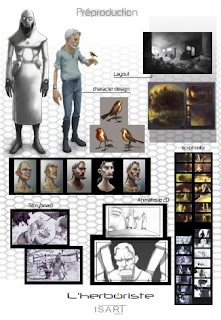Starting my first year, I was overwhelmed with the amount of work we get, compared to other degrees done by my dorm friends, however.. considering the circumstances and nature of the course, it is vital to push your skill level to the high standards the game industry require you to be at in 3 years’ time. I had problems overcoming the steep learning curve barriers, of learning new software’s and drawing techniques, in four things mainly, 3DS Max, Photoshop, Perspective, and Rendering techniques. I’ve learnt, before I can even start being creative and producing decent work, I need to understand the basic principle of each one, and how they work comfortably.
Positive Points
· I have really enjoyed the game Industry lecture talks we have had over the year. I get so much from it, and inspire you to no end, and it’s really a privilege to be a part of that.
· Regular life drawing classes throughout the year, is really important towards your drawing development skills; I am happy it was available consistently.
· The curriculum and content of the course is good. When I did Art A Level I never learnt anything about environment perspective. A big part of it is the way it’s taught; you no longer draw from images, rather than real life.
· The thing I like about the course, is there are 3 parts, which are all connected to each other like a cog-wheel; they need each other. Visual design creates your basic artistic core; it teaches you the principle of perspective, human anatomy and colour theory which translates to game production, helping with your environment and character creation in 3ds Max. Critical studies helps change the way you think in terms of the way the game works, art direction in film and the basic history and technology of games which all help each other.
· You get the opportunity to go into workshops for usage of art facilities, e.g. wood, soft modelling etc. which is an extra luxury that can assist you in your sculptor modelling.
· Writing is one of my weak points, and don’t particularly enjoy writing essays. I really like the fact Critical studies is introduced in a Blogging fashion; it leaves and gives you more creativity and opinion. And definitely more appealing then handing in 20 word documentation essays.. every year, it also gives you a chance to review your class mates blogs and see how they think.
Suggestive Improvements
· The Visual Design room is very cramped; it feels like the room was created for 10 people in mind, when there’s five times the amount. A bigger room, with tables designed to accommodate still life objects rendered from different angles effectively. (On one side of the room) Projector and chairs for lectures talks and White board for demonstration tutorials on perspective etc. on the other side.
· Life Drawing class is cramped; if you don’t get a box stump or a stand up canvas holder, you’re stuck with the floor, because there’s so many people. You don’t really get a good view of the model. I think splitting the groups would be handy or finding another room.
· I would have liked Photoshop being taught in year one;most people’s final pieces in Visual design are done in Photoshop, so It’s a shame we don’t get taught it.
· I don’t feel enough feedback is given throughout the course. In formative assessment, your more informed of what you didn’t do then on feedback on what you did do.
I think both equally are very helpful.
· I feel year 1 grading system is too high, considering it’s a learning period. It’s a lot harder to get a 65% since you spend 90% of your time.. Learning the software, drawing and colouring techniques to get to high standards. Its puts keeping your scholarship at a disadvantage.
· Video tutorials in 3DS Max, would be more handy then PFDS; they’re a lot easier to follow and don’t miss out chunks of detail your expected to know already.
Conclusion
Overall I am really disappointed in myself; I did not get to the skill level I expected at the end of the year. I will use summer vacation to correct this. A big part of this problem was time management and self-discipline and organisation.
I really enjoyed my first year, and liked the content and curriculum of the course. The teachers definitely know their stuff and lectures can be inspiring. I do sometimes feel my brain can’t keep up with the amount of information they throw at me.. and am intimidated to ask for help, in case they think I’m stupid. If I am struggling understanding something, I start to get frustrated, get migraines and really annoyed; I don’t know how to fix the problem. Not being able to overcome such a thing, can break you from accomplishing your goal; I am not ready to give up!






















